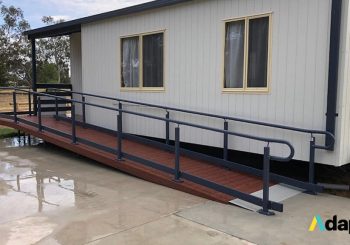Most homes these days come with decks and outdoor spaces with handrails installed. Since they’re already part of the space, they’re often taken for granted.
It’s easy to overlook or forget the importance of handrails. As a refresher, here is a quick list of the benefits they provide. Understanding their purpose and advantages can allow you to better design your outdoor space and enhance the value and safety of your home.
-
Safety and security
More than anything, handrails can help ensure safety and security at home. They allow people to feel more comfortable in their outdoor space knowing that these safety features are in place to prevent falls. This is especially important for families with young children, people with disabilities, and pets.
-
Stability on outdoor steps
When navigating steps, a person can lose balance due to various factors. These include accidentally missing a step, experiencing vertigo, or having mobility issues because of an injury. Handrails provide an immediate surface people can grab on to in case they lose their balance, helping prevent accidents.
Households with family members who are elderly and with disabilities also benefit greatly from having handrails on outdoor steps. In addition to ensuring the safety of their loved ones, these features also help promote independence. Customised handrail systems can be designed to fit your home requirements.
-
Compliance with Australian laws
Installing hand railings on your property also ensures compliance. The Building Code of Australia (BCA) requires handrails on exposed landings that are one metre or above a floor or building. Although spaces below one metre (1m) are not required, it is still advised depending on the height.
For decks that stand over four metres (4m), there shouldn’t be elements that people can climb over, between 150mm and 760mm. This requirement prohibits horizontal balustrades and allows vertical ones, provided there are no footholds. Spaces between the balustrades should also be less than 125mm to prevent things from falling through them.
In addition, the Australian Standard AS 1657 requires properties to have handrails installed on exposed sides of platforms, landings, and walkways that exceed 300mm. The law also requires a toe board or kick plate, within 10mm from the edge, in spaces where an object can fall from and people have access to the area below.
With handrails installed in your home, anyone can enjoy spending time outdoors regardless of their accessibility needs. A breath of fresh air, some sun, and views of the outdoors are known to provide various physical and psychological benefits. Make the most of your space while also keeping it safe and secure with handrail systems designed to fit your home needs.
Interested in developing a bespoke handrail system for your home? Adapta has been in the industry for over 20 years, helping residential and commercial clients create custom-made, intuitive, and straightforward inclusive spaces for all. Our team of professionals will be more than happy to help. Get in touch with us today!



